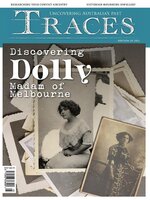Traces magazine delves deep into Australia’s history, from ancient Indigenous heritage to colonial times,convicts, local history, antiques and artefacts, family genealogy and more!
Welcome to the 29th edition of Traces!
Traces
Heritage news
Never miss out with a Traces subscription
Customs House, Brisbane Then & Now • Brisbane’s Customs House was the bustling heart of the city’s trade and commerce industry in the late 1800s and early 1900s.
Face value: the physiognomy fad • How our faces have been read and misread in the past.
What would physiognomy say about you? • In his 1901 book, Physiognomy: The Science of Physiognomy Explained in the Form of Question and Answer, Frank Ellis wrote that there are five face shapes: round, square, long, pyriform and oblong. He noted the following information about face shape and what this was supposed to say about a person.
Austrialia del Espiritu Santo • Many Australians have only a vague understanding of how our nation came to be called ‘Australia’. Natalie Lonsdale uncovers the real story.
Ruling the waves • The art of charts relied on skilled sailors like Willoughby Pudsey Dawson of the Royal Navy.
The life and times of an early Melbourne detective • Have you ever wondered what kind of lives were led by Australian detectives in the Victorian era? The life of Detective James George Seabridge was characterised by poverty, illness and perseverance.
Starting out in family history • Have you ever wondered if the family legend about your great-grandmother was true? Have you found a box of family photographs and would like to know who is pictured? Maybe you’re just curious about your family’s past? This edition, Cassie Gilmartin provides a beginner’s guide to getting started in family history research.
The lost and found of World War II • It happened one night. The message swept through the neighbourhood; it was time to flee.
What’s that thingamajig? • Answer: a smoking pipe and pipe holder
The use and beauty of the aerial photograph
How to use the photographic map mosaics
The almost unknown soldier • William Thorburn’s short life was characterised by adversity and perseverance in the face of obstructors. In death, Thorburn was a symbol for fellow returned soldiers of their own personal postwar struggles.
Speaking ‘Australianese’ • Australian English is about more than just an accent; it’s also about the words we use. Amanda Laugesen takes a look at what our language can tell us about the Australian story.
Quintessentially Australian words and expressions
From roast wombat to vanilla ice • Australia’s oldest surviving recipe book offers a fascinating glimpse of life 160 years ago, but how is the food? This edition, Eden Cox explores The English and Australian cookery book, and tests out one of its recipes.
When the walls can talk • Earlier this year, a routine home renovation in Richmond, Tasmania, led to an unexpected treasure: the discovery of rare, 200-year-old wallpaper. Traces spoke with homeowners Betty Robinson and Mark Courtinay, and wallpaper expert and historian Alan Townsend, about the fascinating find.
DO YOU HAVE A STORY TO SHARE? • Traces welcomes article submissions and pitches from historians, genealogists, family history researchers, authors and history lovers.

 Edition 29, 2024
Edition 29, 2024
 Edition 28, 2024
Edition 28, 2024
 Edition 27, 2024
Edition 27, 2024
 Edition 26, 2024
Edition 26, 2024
 Edition 25, 2023
Edition 25, 2023
 Edition 24, 2023
Edition 24, 2023
 Edition 23, 2023
Edition 23, 2023
 Edition 22, 2023
Edition 22, 2023
 Edition 21, 2022
Edition 21, 2022
 Edition 20, 2022
Edition 20, 2022
 Edition 19, 2022
Edition 19, 2022
 Edition 18, 2022
Edition 18, 2022
 Edition 17, 2021
Edition 17, 2021
